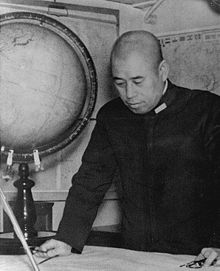Isoroku Yamamoto: Japan's Visionary Admiral
Part 1: The Building of an Empire Isoroku Yamamoto was a Japanese admiral and commander-in-chief of his country's navy for part of World War II. He is perhaps most well-known as the architect of the surprise attack on Pearl Harbor. When Isoroku was born, in 1884, his father, Sadayoshi Takano, was a samurai, a member of the fierce warrior class that had ruled Japan for many years. Samurai influence had waned by this time, however, as the country proceeded with an industrialization begun after the Meiji Restoration and encouraged by advisors from Prussia. Isoroku graduated from the Imperial Japanese Naval Academy in 1904 and served aboard an armored cruiser during his country's victory in the Russo-Japanese War. Wounded during the Battle of Tsushima, he lost the index and middle fingers on his left hand. After the war, he returned to the Naval Staff College and in 1916 achieved the rank of Lieutenant Commander. The Yamamoto family in 1916 adopted Isoroku, and he took their name. Two years later, he married Reiko Mihashi. The couple eventually had two sons and two daughters. 
Isoroku, now Yamamoto, studied at Harvard University in 1919–1921 and also served as a Japanese naval attaché in Washington, D.C. A fluent speaker of English and keen observer, he traveled extensively in the U.S. and learned much about that country's customs, business practices, and government policies. He also learned about the strength and capacity of the U.S. military. Yamamoto achieved the rank of Captain in 1923 and was later promoted to Rear Admiral and Vice Admiral. He very much appreciated the military potential of naval aviation and served as head of the Aeronautics Department for a time. This appreciation and experience no doubt helped him gain the command of the First Carrier Division. Yamamoto was more a proponent of gunboat diplomacy, using military strength to achieve political and economic gains, than of military invasion to achieve those ends. This put him at odds with many in the Japanese government and military in the 1930s. He opposed the invasion of Manchuria and the wider war with China. He opposed Japan's signing of the Tripartite Pact with Germany and Italy. He knew the military capability of the U.S. and cautioned against war with that country. And yet he kept his high ranking in the Japanese Navy, primarily because he had tremendous support from the rank-and-file and from the imperial family. In November 1940, he was promoted to Admiral. Part 2: The Last Years of His Life |
|




